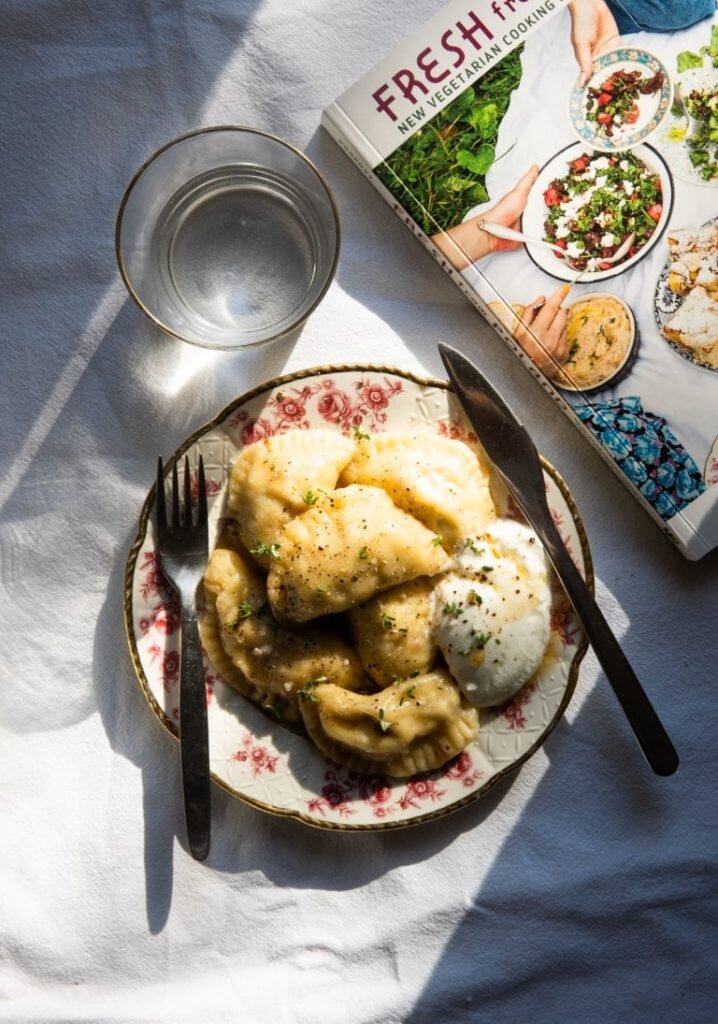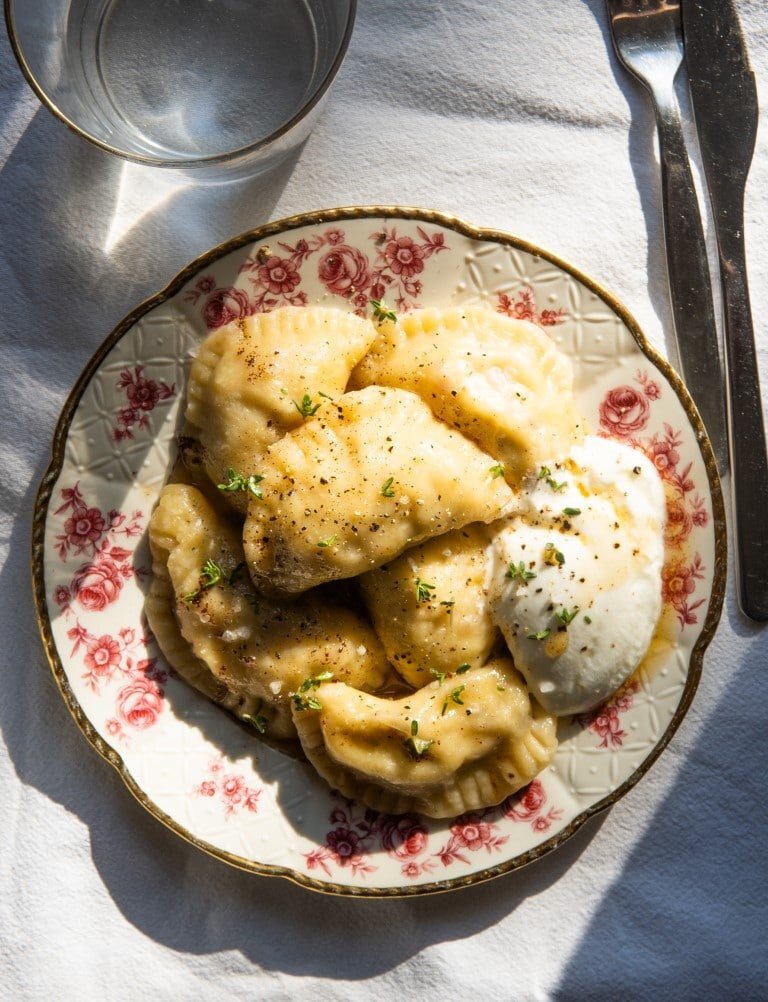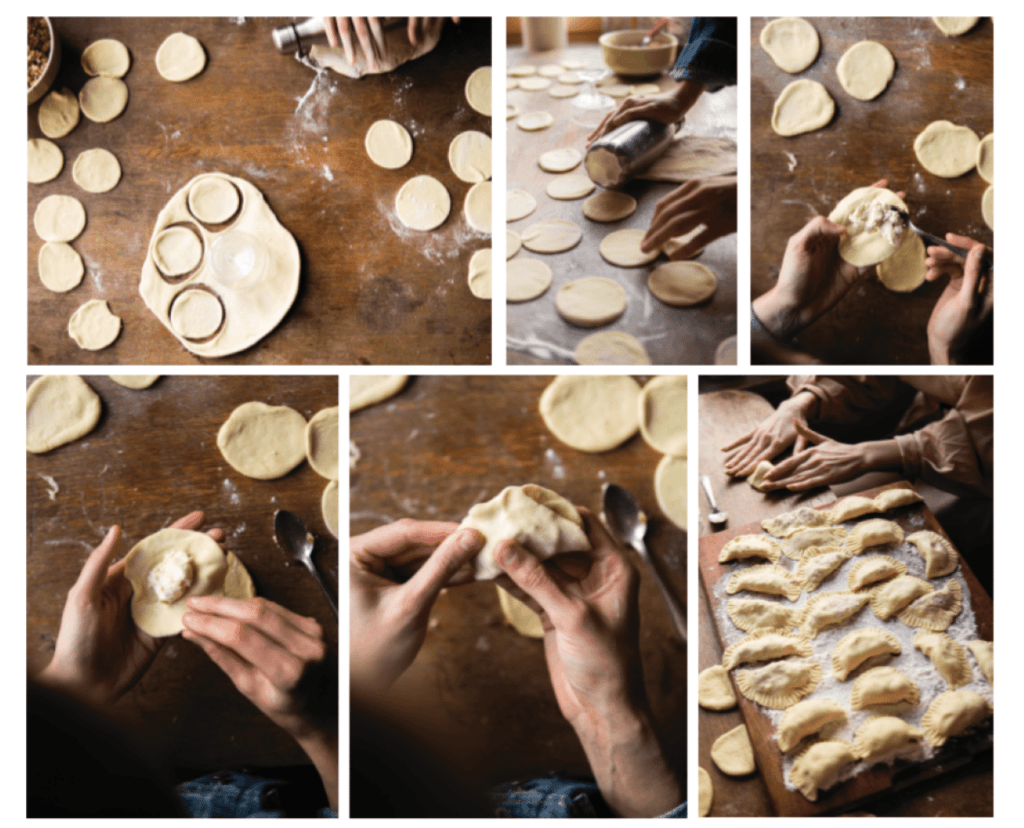Making pierogi is so relaxing. It’s a moment when you can sit down, gather your thoughts, and don’t have to rush anywhere.
Everyone thinks that their recipe for dumpling dough is the best. I do, too. (Shout-out to my grandma, basically it’s her recipe.) Many pierogi recipes contain yolks or whole eggs. But I don’t use them, because I think they make the dough harder. The key to success is a large amount of cold-pressed rapeseed oil, which makes the dough perfectly soft and gives it an amazing nutty scent. The consistency is the most important part—sometimes you have to sprinkle the dough with more flour or add a little water to achieve a nice ball. Practice makes perfect: Keep trying, and soon you will be just like a real Polish grandmother.
One of the most beloved Polish classics, pierogi ruskie (“Russian” pierogi), actually have nothing to do with Russia. These pierogi are filled with potatoes mashed with twaróg and a bit of golden-brown onion. The farmer cheese should be fatty and the best quality you can find. It’s also important to add a huge amount of freshly ground black pepper, enough so that it pinches your tongue. Pierogi taste excellent when they are fried, and also straight from the cooking water. In that case, I recommend serving them with warm nutty brown butter. My great-grandmother did it that way, and she really knew her stuff.
This recipe comes from my cookbook Fresh from Poland: New Vegetarian Cooking from the Old Country. There is a whole dumpling chapter! Get a copy if you an appetite for more.
Pierogi Ruskie with Potato, Farmer Cheese, Black Pepper and Brown Butter
makes about 50 pierogi
Dough
3½ cups (450 g) all-purpose flour, plus more for kneading and holding
1 teaspoon salt
¼ cup (60 ml) cold-pressed rapeseed oil (alternatively another vegetable oil)
1 tablespoon sunflower oil, for cooking
Filling & serving
3 starchy potatoes, such as russets (about 1 pound/500 g total), peeled and chopped
12 ounces (2 cups/340 g) farmer cheese or Twaróg (I use this one)
2 tablespoons (30 g) unsalted butter
3 small white onions (10 ounces/ 300 g total), chopped
1/4 cup (½ stick/60 g) unsalted butter
Sour cream, for serving
Flaky sea salt, for serving
Fresh thyme, for serving (optional)
Salt and freshly ground black pepper
1. Start with the filling: Boil the potatoes in generously salted water. Cook until soft, 15 to 20 minutes. Drain, then return them to the pot. Mash the potatoes, add the cheese, and mash again.
2. While the potatoes are boiling, heat the butter in a large skillet. Add the onion and cook, stirring frequently, until golden brown, 10 to 15 minutes. Add the onion to the potato-cheese mixture with ½ teaspoon freshly ground black pepper, and stir to combine. Season with salt and more pepper, to taste. (The filling should be very, very peppery!) Let cool completely.
3. Make the dough: Combine the flour and salt in a large bowl. In a separate bowl, combine the rapeseed oil and 1 cup (230 ml) warm water. Slowly add the liquid ingredients to the flour and mix with a wooden spoon until the dough is well combined. Turn the dough out onto a clean, lightly floured surface and knead for 4 to 5 minutes, until it is smooth and supple. Invert a bowl over the dough and let it rest at room temperature for at least 15 minutes to allow the gluten to relax.
4. Divide the dough into three equal pieces. Place one piece on a lightly floured surface. (Cover the remaining dough with a clean kitchen towel to keep it from drying out.) Using a rolling pin, roll out the dough to a thickness of just less than 1/8 inch (3 mm), lifting up the dough to dust the surface with flour to prevent sticking, if needed.
5. Using a pastry cutter or inverted glass tumbler, cut out 2½-inch (6.4 cm) diameter circles of dough. Roll out the circles even thinner, to 3 inches (7.6 cm). Gather the dough scraps into a ball and set aside. Continue with the other two pieces of dough, and the combined scraps, until all dough is used, making 30 to 50 circles.
6. Put 1 to 2 tablespoons filling in the center of each round, leaving a ¾-inch (2 cm) border. Grasp the dough from opposite ends and pull it up and over the filling, pressing down to seal the edges together and creating a semicircle. Pinch the edges together to seal completely. If the edges don’t adhere, brush them lightly with water, then seal. Do not leave any gaps or the pierogi may open during cooking.
7. Transfer the pierogi to a lightly floured kitchen towel and cover with another towel to prevent drying. Continue until all the dough is used.
8. Boil a large pot of salted water and add the sunflower oil. Working in batches, use a slotted spoon to gently lower 10 to 15 pierogi at a time into the pot. When the pierogi rise to the surface, continue to cook them for 1 to 2 minutes more, then transfer with the spoon to a colander to drain immediately.
9. Meanwhile, heat the remaining butter in a medium saucepan. Cook over low heat until it turns golden brown and starts smelling like nuts, 6 to 8 minutes. Remove from the heat.
10. To serve, divide the pierogi among plates. Drizzle with the brown butter, top with thyme, and serve with sour cream. More Polish recipes to find in my cookbook Fresh from Poland: New Vegetarian Cooking from the Old Country.
Tip
Uncooked pierogi can be stored for up to 2 months. Freeze on baking sheets for about 1 hour, then transfer to a resealable plastic bag. Boil them straight from the freezer, adding 2 minutes to the overall cooking time.
Share a picture of your dish with me on Instagram tagging #rozkoszny @rozkoszny. Smacznego!
Yours,
Rozkoszny



6 comments
Prawdopodobnie najlepsze pierogi jakie jadłam w życiu! Absolutna rozpusta dla kubków smakowych! 🙂
bardzo się cieszę <3
Przepyszne ❤️ Choć ja chyba przesadziłem z pieprzem w farszu 🙈🤭
jak szczypie to bardzo dobrze, wiesz, że żyjesz 😛
Trafiłam w sklepie na twaróg ze Strzałkowa (w Krakowie o niego ciężko), wiec już wiem co gotuję w sobotę:D czy myślisz, że olej z pestek winogron lepiej zastąpić rzepakowym, czy oliwą z oliwek (akurat te dwa mam w domu)?
Rozkoszny plan! Użyłbym oliwy z oliwek